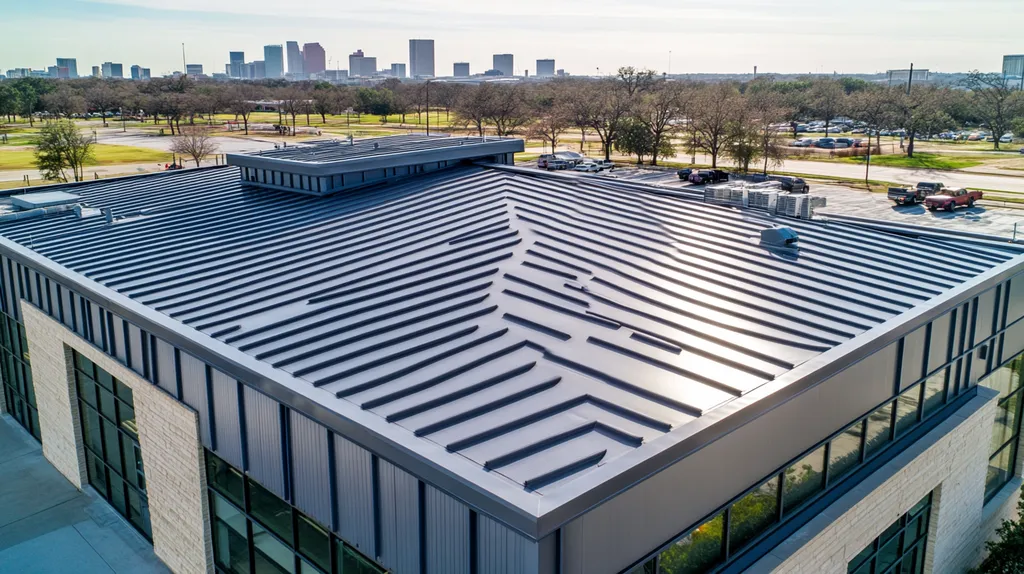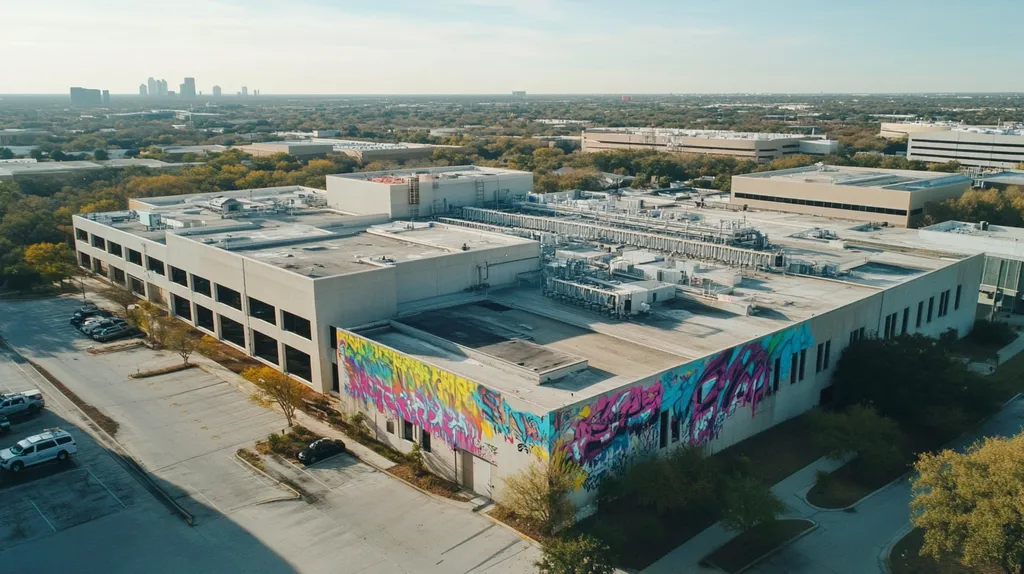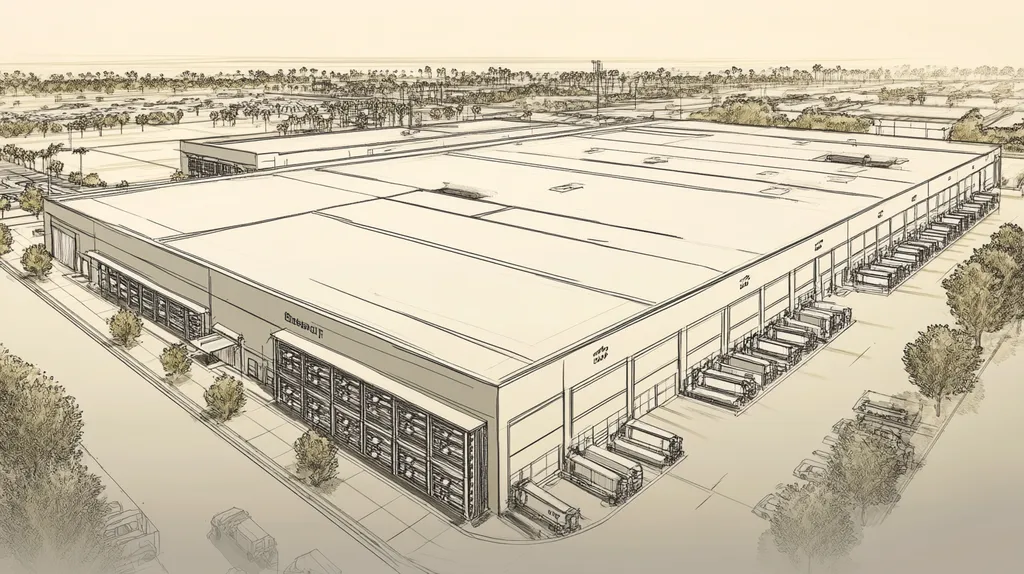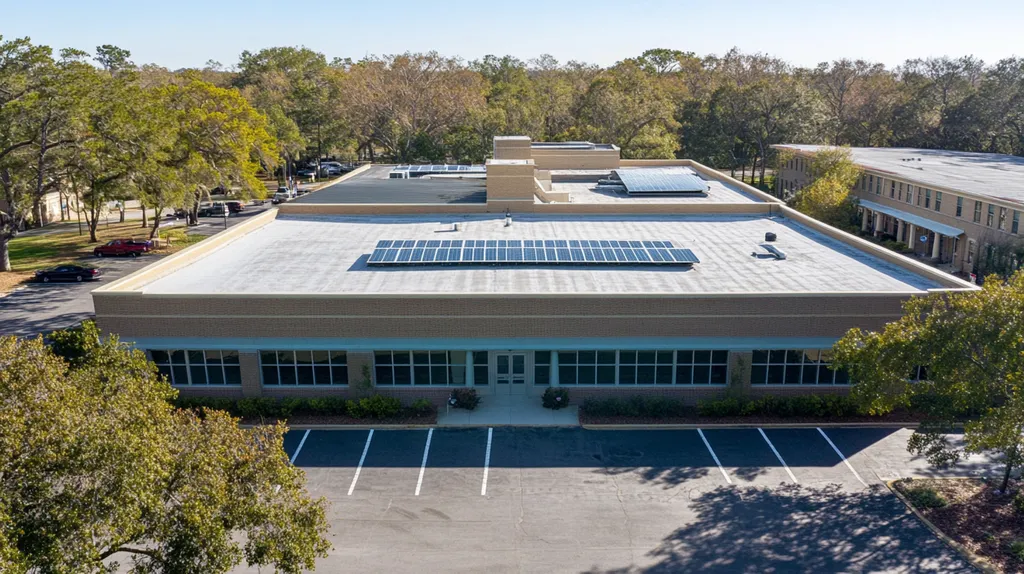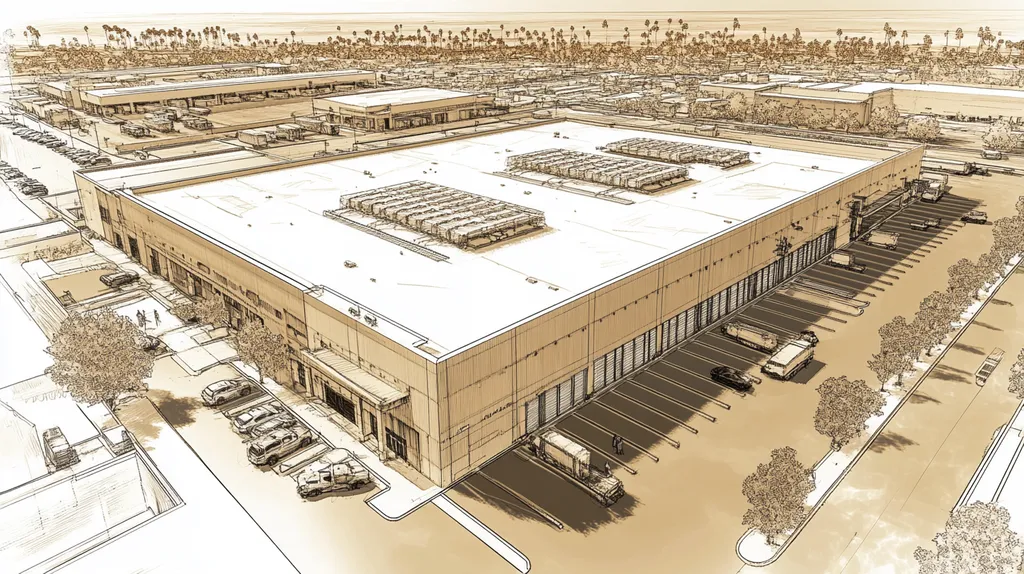In today’s industrial environment, inefficient roofing systems waste up to $3 billion annually in unnecessary energy costs across the U.S. manufacturing sector. With energy expenses typically representing 30% of operational budgets, the roof has become a critical focal point for cost reduction.
Modern industrial roofing solutions can reduce HVAC-related energy costs by up to 40%, yet fewer than 25% of facilities have implemented these technologies.
This comprehensive guide examines how strategic roofing improvements can dramatically reduce operational costs while enhancing facility performance across six key areas.
SECTION 1: THE BASICS EXPLAINED
In today’s industrial environment, energy costs can consume up to 30% of a facility’s operating budget, with roofing systems playing a crucial role in energy management. Every square foot of inefficient roofing can waste hundreds of dollars annually in unnecessary heating and cooling costs. Modern industrial roof solutions offer unprecedented opportunities for energy savings, with some facilities reducing their HVAC-related energy expenses by up to 40% through strategic roofing improvements.
What It Is (In Plain Language)
Industrial roof energy efficiency is about creating a protective barrier that manages heat flow between your building and the outside environment. Think of it as a temperature control system that starts at the top of your facility.
The core components include advanced insulation materials, reflective surfaces, and strategic ventilation systems. These elements work together to keep heat inside during winter and outside during summer.
Modern solutions include cool roofing materials that reflect up to 85% of solar radiation and specialized membrane systems that can self-repair minor damage. These technologies have transformed industrial roofing from a simple weather barrier into an active energy management tool.
Energy-efficient roofing combines these elements into an integrated system that actively contributes to your facility’s overall energy performance.
Why It Matters (To Your Building)
Energy savings through proper roofing practices can deliver payback periods of less than two years, making it one of the most cost-effective facility improvements available. (source: U.S. Department of Energy)
Beyond direct energy savings, efficient roofing extends the life of HVAC systems by reducing their workload. This decreased strain means fewer repairs and longer equipment life spans.
Temperature-stable environments also improve worker productivity and comfort while protecting sensitive inventory and equipment from temperature fluctuations.
Enhanced energy efficiency often qualifies buildings for tax incentives and utility rebates, providing additional financial benefits beyond direct energy savings.
How It Works
Energy-efficient roofing systems operate on multiple levels to control heat transfer. The outer layer reflects solar radiation, while internal insulation layers trap or block heat movement.
Advanced roofing materials create thermal barriers that adapt to changing conditions. During summer, they reflect heat and UV radiation; during winter, they prevent valuable heat from escaping.
Ventilation systems work with these materials to manage moisture and prevent heat buildup in dead spaces. This circulation is crucial for maintaining the roof’s efficiency and preventing condensation issues.
Modern monitoring systems track roof performance in real-time, allowing facility managers to optimize energy usage and identify maintenance needs before they become problems.
SECTION 2: PRACTICAL APPLICATIONS
Industrial facilities face mounting pressure to reduce energy costs while meeting sustainability goals. Up to 40% of a building’s cooling load comes through the roof, making it a critical focal point for energy efficiency. Understanding practical applications of energy-efficient roofing systems helps facility managers implement solutions that deliver measurable returns while enhancing building performance.
Common Uses & Examples
Manufacturing facilities with high heat-generating equipment particularly benefit from cool roofing systems that reflect up to 85% of solar radiation, dramatically reducing cooling demands during peak production hours. (source: U.S. Department of Energy)
Distribution centers and warehouses leverage light-colored membrane systems to maintain consistent interior temperatures, protecting temperature-sensitive inventory while reducing HVAC strain.
Food processing facilities utilize specialized insulation systems that prevent condensation while maintaining strict temperature controls required for food safety compliance.
Data centers implement multi-layer roofing solutions that combine reflective surfaces with advanced insulation to protect sensitive equipment from temperature fluctuations.
When You Need It Most
Facility expansion or renovation presents an ideal opportunity to upgrade roofing systems, as integration with existing infrastructure can be optimized during construction.
Rising energy costs often signal the need for immediate roofing assessment, especially in facilities where HVAC systems run continuously.
Seasonal transitions require proactive evaluation of roofing performance, particularly before extreme weather periods that stress building systems.
Equipment upgrades or changes in facility usage patterns necessitate review of roofing systems to ensure they meet new operational demands.
Interactions With Other Systems
Roofing systems directly impact HVAC performance by reducing thermal load, allowing cooling systems to operate more efficiently and extend their operational lifespan.
Ventilation systems work in concert with energy-efficient roofing to manage moisture levels and prevent heat stratification in tall industrial spaces.
Building automation systems can integrate with modern roofing solutions to optimize energy usage based on real-time environmental conditions.
Lightning protection and drainage systems must be carefully coordinated with energy-efficient roofing to maintain building safety while preserving thermal performance.
SECTION 3: KEY TERMINOLOGY DECODED
Industrial roofing terminology directly impacts facility budgets and operational efficiency. Common misunderstandings about technical specifications lead to over $2 billion in wasted energy costs annually across the industrial sector. Mastering these key terms enables facility managers to make decisions that can reduce energy expenses by up to 35% while extending roof lifespans by 5-10 years.
Essential Terms Explained
R-value measures insulation effectiveness, with higher numbers indicating better heat flow resistance. Modern industrial roofing systems typically require R-values between R-25 and R-30 for optimal energy performance in most climate zones.
Solar Reflectance Index (SRI) quantifies a roof’s ability to reject solar heat. Industrial facilities in warm climates should target materials with SRI values above 78 to minimize cooling costs.
Thermal emittance measures how readily a surface releases absorbed heat. Materials with high emittance (0.85 or greater) help facilities cool more quickly after sunset, reducing nighttime energy consumption.
Air barriers prevent unwanted air movement through the roof assembly. Proper air barrier installation can reduce heating and cooling costs by up to 15% in typical industrial buildings.
Industry Jargon Translated
Thermal bridging occurs when heat bypasses insulation through structural elements. These heat highways typically account for 15-20% of energy loss in industrial roofing systems.
Cool roofing systems combine high reflectance and emittance to minimize heat absorption. These systems can maintain surface temperatures 50-60°F cooler than traditional roofing during peak summer conditions.
Vapor retarders control moisture movement through roofing assemblies. Proper vapor retarder selection prevents condensation that can degrade insulation performance and reduce energy efficiency.
Building envelope refers to the entire exterior shell, including roof, walls, and foundation. Understanding this system approach helps facility managers coordinate repairs and upgrades for maximum energy savings.
Measurement & Units Simplified
U-factor measures total heat transfer through roofing assemblies. Lower U-factors indicate better insulation performance, with modern systems targeting values below 0.05 for optimal efficiency.
Roof load calculations combine dead loads (permanent weight) and live loads (temporary weight). These measurements ensure roofing systems can support additional insulation or solar installations while maintaining structural integrity.
Life-cycle cost analysis examines expenses over the entire roof lifespan. This calculation typically shows energy-efficient systems cost 30-40% less over their lifetime compared to standard roofing, despite higher initial costs.
Payback period calculations help facilities prioritize upgrades. Energy-efficient roofing improvements typically achieve positive returns within 3-5 years through reduced HVAC costs and extended equipment life.
SECTION 4: DECISION FACTORS
Industrial roofing decisions carry significant long-term implications for facility operations and profitability. With energy costs consuming up to 25% of operational budgets, the stakes are exceptionally high. Poor roofing choices can lock facilities into decades of inefficiency, while strategic decisions can reduce energy costs by 15-30% annually. Understanding the interplay between costs, performance, and longevity enables facility managers to make choices that maximize both immediate and long-term returns.
Cost Considerations
Initial installation costs typically represent only 20-30% of a roof’s total lifetime expense. Energy-efficient systems may cost 10-15% more upfront but can deliver payback periods of 3-5 years through reduced HVAC demands.
Maintenance requirements vary significantly between roofing systems. Premium materials often require less frequent maintenance, reducing long-term operational costs while maintaining peak energy performance.
Local utility incentives and federal tax credits can offset 20-30% of energy-efficient roofing costs. These programs change regularly, making timing crucial for maximizing financial benefits.
The Department of Energy emphasizes that cool roofs can dramatically lower building temperatures and reduce cooling costs by reflecting more sunlight than conventional roofs. (source: U.S. Department of Energy)
Performance Trade-offs
Material selection directly impacts both energy efficiency and structural performance. High-reflectivity membranes excel at heat rejection but may require additional reinforcement in high-traffic areas.
Climate considerations significantly influence roofing performance. Northern facilities benefit more from increased insulation values, while southern locations see greater returns from reflective surfaces.
Warranty coverage varies based on system complexity and installation quality. Premium systems typically offer longer coverage periods but require certified installers to maintain validity.
Integration with existing building systems affects overall performance. Roofing choices must account for ventilation requirements, structural loads, and drainage patterns to maximize efficiency.
Lifespan & Durability Factors
System longevity directly correlates with material quality and installation expertise. Premium systems typically last 20-30 years, while standard solutions may require replacement in 10-15 years.
Environmental exposure impacts durability significantly. UV radiation, temperature cycling, and chemical exposure can degrade energy-efficient properties over time, requiring proper material selection for specific conditions.
Regular inspections and maintenance programs extend system lifespan. Proactive care can maintain energy efficiency levels while preventing minor issues from escalating into major repairs.
End-of-life considerations affect total ownership costs. Some materials offer recycling potential, reducing disposal expenses while supporting sustainability goals.
SECTION 5: COMMON CHALLENGES
Industrial roofing systems face increasing pressure from extreme weather, aging infrastructure, and rising energy costs. Studies show that 75% of industrial facilities experience energy-related roofing issues that go undetected for months or years. These challenges can increase energy costs by up to 40% while accelerating roof deterioration. Understanding and addressing these issues proactively is crucial for maintaining building efficiency and controlling operational costs.
Frequent Problems & Solutions
Membrane degradation represents one of the most common efficiency challenges, with UV exposure and thermal cycling breaking down protective layers. This deterioration can reduce reflective properties by up to 30% within five years, dramatically increasing cooling costs.
Poor insulation compression and displacement often occurs due to foot traffic and equipment installation. Even minor compression can reduce insulation effectiveness by 25%, creating cold spots and energy waste zones.
Moisture infiltration through improperly sealed penetrations and flashing remains a persistent threat. When insulation becomes wet, its R-value can drop by up to 40%, creating a cascade of energy efficiency problems.
Solutions include installing high-durability membrane systems with superior UV resistance, creating designated roof access pathways, and implementing comprehensive moisture detection systems.
Warning Signs To Watch For
Increased energy bills despite consistent usage patterns often signal developing roof problems. Monthly variations exceeding 15% warrant immediate investigation, as they typically indicate serious efficiency losses.
Interior ceiling discoloration or staining may indicate water infiltration that compromises insulation performance. These visual markers often appear months before serious energy efficiency impacts become apparent.
Membrane surface changes, including chalking, cracking, or blistering, indicate degradation of protective properties. These changes can reduce solar reflectance by up to 50%, significantly increasing cooling loads.
Gaps or separation at roof penetrations and edges create thermal bridges that bypass insulation. Even small breaches can impact energy efficiency across large sections of roofing.
Preventative Approaches
Regular infrared scanning can detect moisture infiltration and insulation problems before they impact energy bills. Modern scanning technology can identify problems months before they become visible through conventional inspection.
Implementing a roof asset management program with scheduled inspections and maintenance reduces emergency repairs by 60%. These programs should include quarterly visual inspections and annual technical assessments.
Installing roof monitoring systems provides real-time performance data and early warning of developing issues. These systems can track temperature variations, moisture levels, and membrane condition continuously.
Strategic coating applications can restore reflective properties and extend membrane life. The U.S. Department of Energy notes that cool roof coatings can significantly lower building temperatures and reduce cooling costs by reflecting more sunlight than conventional roofing systems. (source: U.S. Department of Energy)
SECTION 6: NEXT STEPS & RESOURCES
Industrial roofing decisions carry significant financial implications, with inefficient systems wasting up to 30% of facility energy costs annually. Taking informed next steps requires understanding both immediate actions and long-term strategies. Modern industrial facilities face increasing pressure to optimize roof performance while navigating complex technical specifications, material choices, and installation requirements.
Questions To Ask Providers
Begin by requesting detailed energy performance data from previous installations, including before-and-after utility costs. This establishes a baseline for evaluating potential savings and validates provider claims.
Examine their certification credentials and specialized training in energy-efficient systems. Providers should demonstrate expertise with multiple material types and installation methods suited to your facility’s specific needs.
Request comprehensive lifecycle cost analyses that include installation, maintenance, and projected energy savings. The U.S. Department of Energy emphasizes that effective operations and maintenance strategies can deliver payback periods under two years through reduced energy expenses. (source: U.S. Department of Energy)
Verify their quality control processes and post-installation monitoring capabilities. Leading providers offer detailed documentation and regular performance verification protocols.
Industry Standards & Guidelines
ASHRAE 90.1 provides fundamental benchmarks for roof insulation and thermal performance. This standard establishes minimum requirements that vary by climate zone and building type.
Cool Roof Rating Council (CRRC) ratings measure solar reflectance and thermal emittance. These metrics help facilities evaluate material performance under standardized conditions.
Factory Mutual (FM) and Underwriters Laboratories (UL) certifications ensure materials meet rigorous safety and performance standards. These ratings become especially critical in regions with extreme weather conditions.
Building codes increasingly mandate specific energy efficiency levels for industrial roofing. Stay current with local requirements to avoid costly retrofits or compliance issues.
Further Learning Simplified
Professional organizations like NRCA and SPRI offer technical bulletins and educational resources focused on energy efficiency. These materials translate complex concepts into practical guidelines.
Manufacturer training programs provide hands-on experience with specific systems and materials. These sessions often include installation demonstrations and maintenance protocols.
Industry conferences and trade shows showcase emerging technologies and best practices. These events offer opportunities to evaluate multiple solutions simultaneously.
Online certification programs through recognized authorities provide structured learning paths. These courses help facility managers develop expertise in energy-efficient roofing systems.
The Bottom Line
With industrial facilities wasting over $3 billion annually through inefficient roofing, the stakes for implementing energy-efficient solutions have never been higher.
Modern roofing technologies now offer unprecedented opportunities to reduce energy costs by 30-40% while extending system lifespans by up to 15 years.
Yet fewer than 25% of facilities have implemented these proven solutions, leaving significant cost-saving potential untapped across the industrial sector.
As energy costs continue rising and climate challenges intensify, facilities that prioritize roof efficiency today will gain substantial competitive advantages through reduced operational expenses and improved building performance.
The time for strategic roofing improvements is now – before rising energy costs and aging infrastructure create even greater financial burdens.
FREQUENTLY ASKED QUESTIONS
Q. What is commercial roof energy efficiency?
A. Commercial roof energy efficiency involves managing heat flow to save energy costs. Effective materials and systems help maintain temperature control, which directly impacts HVAC performance and operating expenses.
Q. How does an industrial roof impact energy savings?
A. An industrial roof can account for a significant portion of cooling loads. By implementing energy-efficient solutions, facilities can lower energy consumption and improve overall temperature regulation, thus enhancing savings.
Q. What terms should I know about industrial roofs?
A. Key terms include R-value, solar reflectance index, and thermal emittance. Understanding these concepts helps managers make informed decisions about roof selection and energy savings potential.
Q. What factors should I consider for a commercial roof?
A. Consider initial costs, long-term energy efficiency, and maintenance needs. Choosing the right materials can significantly impact both performance and overall energy expenses over time.
Q. What challenges do industrial roofs typically face?
A. Common challenges include membrane degradation, moisture infiltration, and poor insulation. Proactive maintenance and monitoring can prevent serious energy losses and enhance roof lifespan.
Q. What steps should facilities take for roof upgrades?
A. Start with an energy audit, request performance data from providers, and consider lifecycle costs. Understanding these aspects will help maximize energy efficiency and financial savings during upgrades.
Q. How do different climates affect industrial roofs?
A. Climate significantly impacts material selection and energy performance. Colder areas benefit from increased insulation, while warmer regions gain from reflective roofing materials to enhance energy efficiency.

